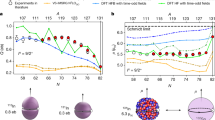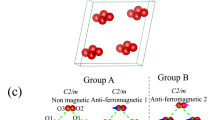Abstract
THE static dipolar interaction between the nuclei in a solid causes its nuclear magnetic resonance spectrum to be much broader than that of a liquid. In the liquid state the isotropic re-orientation and diffusion of the molecules average their nuclear dipolar interaction almost to zero, often revealing a fine structure originating from the different chemical shifts of the nuclei, and from their indirect spin–spin interactions. In solids this fine structure is obscured by the stronger dipolar interactions. As we have shown previously1–3, the dipolar broadening may nevertheless be removed in solids also, the necessary averaging being achieved by high-speed rotation about an axis inclined at an angle 54° 44′ to the direction of the applied field. When the rotation-rate is comparable with the static line-width, the narrowed central line is resolved from the satellite lines which appear on either side of it at integral multiples of the rotation frequency. Thus, for example, rotation of solid sodium chloride at a rate of 800 c./s. gives a resolved sodium-23 spectrum consisting of a central line and three pairs of satellites2. At a rotation-rate of 1,600 c./s. the central line and only one pair of weak well-resolved satellites are observed, while at 2,500 c./s. only the narrow central line is visible.
This is a preview of subscription content, access via your institution
Access options
Subscribe to this journal
Receive 51 print issues and online access
$199.00 per year
only $3.90 per issue
Buy this article
- Purchase on Springer Link
- Instant access to full article PDF
Prices may be subject to local taxes which are calculated during checkout
Similar content being viewed by others
References
Andrew, E. R., Bradbury, A., and Eades, R. G., Nature, 182, 1659 (1958).
Andrew, E. R., Bradbury, A., and Eades, R. G., Nature, 183, 1802 (1959).
Andrew, E. R., Colloque Ampère, London, April 2, 1959 ; Arch. Sci., 12, 103 (1959).
Clark, D., Powell, H. M., and Wells, A. F., J. Chem. Soc., 642 (1942).
Gutowsky, H. S., and McCall, D. W., J. Chem. Phys., 22, 162 (1954).
Van Wazer, J. R., Callis, C. F., Shoolery, J. N., and Jones, R. C., J. Amer. Chem. Soc., 78, 5715 (1956).
Gutowsky, H. S., McCall, D. W., and Slichter, C. P., J. Chem. Phys., 21, 279 (1953).
Author information
Authors and Affiliations
Rights and permissions
About this article
Cite this article
ANDREW, E., BRADBURY, A., EADES, R. et al. Fine Structure of the Nuclear Magnetic Resonance Spectra of Solids: Chemical Shift Structure of the Spectrum of Phosphorus Pentachloride. Nature 188, 1096–1097 (1960). https://doi.org/10.1038/1881096b0
Issue Date:
DOI: https://doi.org/10.1038/1881096b0
Comments
By submitting a comment you agree to abide by our Terms and Community Guidelines. If you find something abusive or that does not comply with our terms or guidelines please flag it as inappropriate.



